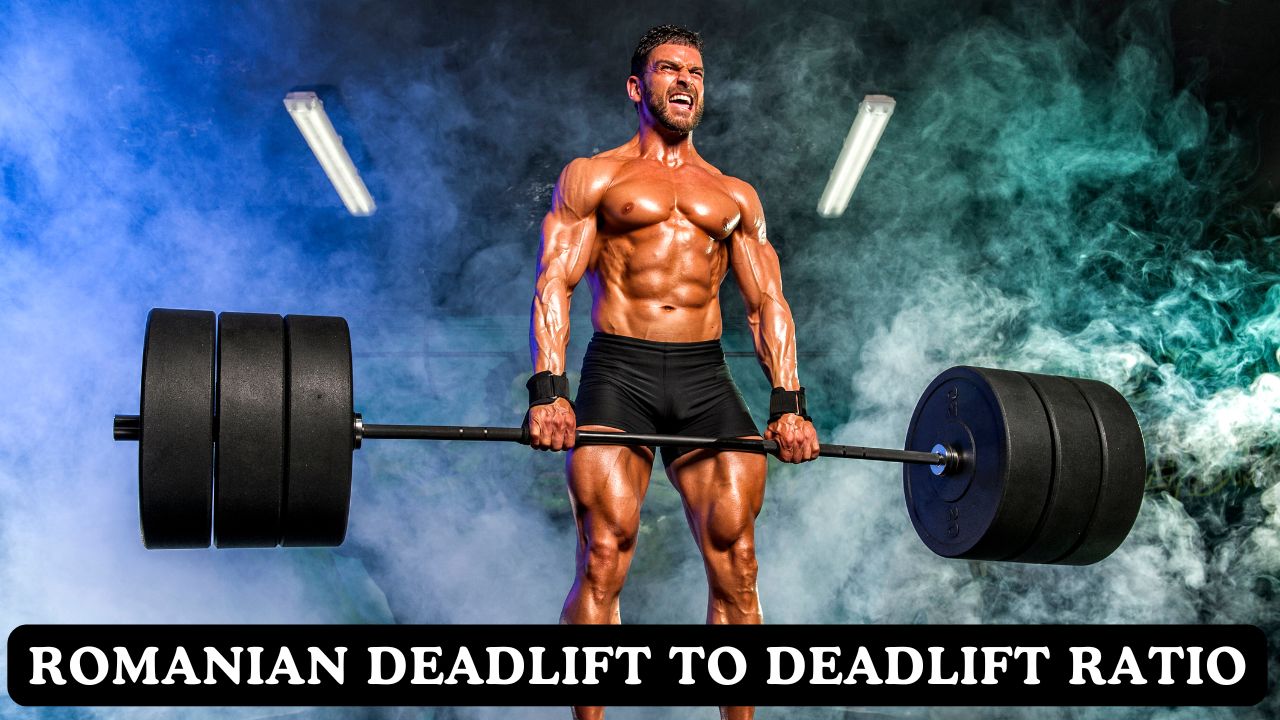Romanian Deadlift to Deadlift Calculator
Convert your Romanian deadlift strength to conventional deadlift using scientific muscle activation ratios. Plan your training with accurate strength predictions based on biomechanical research.

Romanian Deadlift to Conventional Deadlift Conversion
Romanian deadlifts (RDLs) are a hip-hinge movement that starts from the top position, unlike conventional deadlifts that begin from the floor. This difference in starting position and range of motion creates unique muscle activation patterns. Research shows that RDLs provide superior hamstring activation compared to conventional deadlifts, making them excellent for building posterior chain strength and improving hip mobility.
Why Convert Between Deadlift Variations?
Understanding strength ratios between deadlift variations helps you plan better training programs and set realistic goals. If you’re strong at Romanian deadlifts, you can predict your conventional deadlift potential and vice versa. This knowledge helps create balanced training programs that address weaknesses and maximize strength development across all movement patterns.
The Science Behind Strength Ratios
Strength ratios between deadlift variations are based on biomechanical differences and muscle activation patterns. Romanian deadlifts typically allow 85% of your conventional deadlift weight due to the reduced range of motion and different starting position. Understanding these ratios helps optimize your training whether you’re working out at home or in the gym.
Deadlift Variation Conversion Chart
| From Exercise | To Romanian Deadlift | To Conventional Deadlift | To Stiff-Leg Deadlift | To Sumo Deadlift | To Trap Bar Deadlift |
|---|---|---|---|---|---|
| Romanian Deadlift | 100% | 118% | 96% | 112% | 127% |
| Conventional Deadlift | 85% | 100% | 82% | 95% | 108% |
| Stiff-Leg Deadlift | 104% | 122% | 100% | 116% | 132% |
| Sumo Deadlift | 89% | 105% | 86% | 100% | 114% |
| Trap Bar Deadlift | 79% | 93% | 76% | 88% | 100% |
How to Use: Find your current exercise in the left column, then look across to see what percentage of that weight you should be able to lift in other variations. For example, if you Romanian deadlift 100kg, you should be able to conventional deadlift approximately 118kg.
Muscle Activation Differences Between Deadlift Variations
| Exercise | Hamstring Activation | Glute Activation | Lower Back Activation | Best For |
|---|---|---|---|---|
| Romanian Deadlift | Very High (95%) | High (88%) | Moderate (85%) | Hamstring development, hip mobility |
| Conventional Deadlift | High (85%) | Very High (95%) | Very High (95%) | Overall strength, powerlifting |
| Stiff-Leg Deadlift | Maximum (100%) | High (90%) | Moderate (82%) | Hamstring flexibility, development |
| Sumo Deadlift | Moderate (75%) | Maximum (100%) | High (88%) | Glute development, quad strength |
| Trap Bar Deadlift | Moderate (70%) | High (85%) | Low (75%) | Beginner-friendly, reduced back stress |
Training Tip: Use these activation percentages to choose the right deadlift variation for your goals. Combine different variations in your leg workouts to target all muscle groups effectively.
Romanian Deadlift Benefits and Training Applications
🎯 Primary Benefits of Romanian Deadlifts
Superior Hamstring Development: RDLs provide the highest hamstring activation of all deadlift variations, making them essential for balanced leg development.
Improved Hip Mobility: The hip-hinge pattern in RDLs enhances hip flexion and teaches proper movement mechanics for daily activities.
Reduced Lower Back Stress: Starting from the top position reduces the stress on your lower back compared to conventional deadlifts.
Better Posterior Chain Balance: RDLs help balance quad-dominant training
by specifically targeting the often-neglected posterior chain muscles.
📈 When to Use Romanian Deadlifts
Beginner-Friendly Introduction: Start with RDLs before progressing to conventional deadlifts to learn proper hip-hinge mechanics.
Accessory Work for Powerlifters: Use RDLs as accessory exercises to strengthen weak points in your conventional deadlift.
Hamstring-Focused Training: Include RDLs in your leg day routine when targeting hamstring development specifically.
Injury Prevention: RDLs strengthen the posterior chain
which helps prevent lower back injuries and improves posture.
Proper Romanian Deadlift Form and Technique
🔧 Step-by-Step Romanian Deadlift Technique
1. Starting Position: Stand with feet hip-width apart, holding a barbell with an overhand grip, hands about shoulder-width apart.
2. Hip Hinge Initiation: Push your hips back while keeping a slight bend in your knees. Your chest should stay up and shoulders back.
3. Lowering Phase: Continue pushing hips back until you feel a deep stretch in your hamstrings. The bar should stay close to your legs.
4. Return Phase: Drive your hips forward to return to the starting position, squeezing your glutes at the top.
5. Breathing: Breathe in during the lowering phase and out during the lifting phase
to maintain proper core stability.
⚠️ Common Romanian Deadlift Mistakes to Avoid
Rounding the Back: Keep your spine neutral throughout the movement. A rounded back increases injury risk and reduces effectiveness.
Squatting Instead of Hinging: This is a hip-hinge movement, not a squat. Focus on pushing your hips back, not bending your knees.
Bar Drifting Away: Keep the bar close to your body throughout the movement. It should almost brush your legs.
Going Too Low: Stop when you feel a good hamstring stretch. Going too low can compromise form and increase injury risk.
Neglecting the Glutes: Squeeze your glutes hard at the top
to complete the hip extension and maximize muscle activation.
Programming Romanian Deadlifts in Your Training
| Training Goal | Sets | Reps | Weight (% of 1RM) | Rest Between Sets |
|---|---|---|---|---|
| Strength Building | 3-5 | 3-6 | 80-90% | 3-5 minutes |
| Muscle Building | 3-4 | 6-12 | 65-80% | 2-3 minutes |
| Endurance/Conditioning | 2-3 | 12-20 | 50-65% | 1-2 minutes |
| Technique Learning | 3-4 | 5-8 | 40-60% | 2-3 minutes |
Weekly Frequency: Include Romanian deadlifts 1-2 times per week in your leg or back training sessions, allowing at least 48 hours between sessions for proper recovery.
Romanian Deadlift Variations for Different Fitness Levels
🟢 Beginner-Friendly Variations
Dumbbell Romanian Deadlift: Start with dumbbells to learn the movement pattern with lighter weight and better balance.
Kettlebell Romanian Deadlift: Kettlebells provide a different grip and weight distribution
that can be easier for beginners to handle.
Bodyweight Hip Hinge: Practice the movement pattern without any weight to master the hip-hinge mechanics.
Elevated Romanian Deadlift: Stand on a small platform to increase range of motion gradually as flexibility improves.
🔴 Advanced Variations
Single-Leg Romanian Deadlift: Challenges balance and unilateral strength while maintaining the hip-hinge pattern.
Deficit Romanian Deadlift: Stand on a platform to increase range of motion and hamstring stretch.
Paused Romanian Deadlift: Add a 2-3 second pause at the bottom to increase time under tension.
Tempo Romanian Deadlift: Control the eccentric phase with a 3-5 second lowering
to maximize muscle activation and strength gains.
Frequently Asked Questions About Romanian Deadlifts
Q: How much weight should I use for Romanian deadlifts compared to conventional deadlifts?
A: Generally, you should be able to Romanian deadlift about 85% of your conventional deadlift weight. For example, if you can conventional deadlift 100kg, you should be able to Romanian deadlift around 85kg. However, this ratio can vary based on your training experience and individual strengths.
Q: Should I do Romanian deadlifts on leg day or back day?
A: Romanian deadlifts work both your hamstrings and back muscles, so they can fit into either session. Many people include them in leg workouts since they primarily target the hamstrings, but they also work well as a back exercise.
Q: How low should I go during Romanian deadlifts?
A: Lower the bar until you feel a good stretch in your hamstrings, typically around mid-shin level. Don’t force the range of motion – your flexibility will improve over time. Going too low can compromise your form and increase injury risk.
Q: Can I do Romanian deadlifts if I have lower back problems?
A: Romanian deadlifts can actually help strengthen your lower back when performed correctly. However, if you have existing back problems, consult with a healthcare provider or qualified trainer first. Start with lighter weights and focus on perfect form to avoid aggravating any issues.
Q: What’s the difference between Romanian deadlifts and stiff-leg deadlifts?
A: Romanian deadlifts start from the top and maintain a slight knee bend throughout the movement, while stiff-leg deadlifts typically start from the floor with straighter legs. RDLs are generally safer and more beginner-friendly while still providing excellent hamstring development.
Q: How often should I do Romanian deadlifts?
A: Most people benefit from doing Romanian deadlifts 1-2 times per week, allowing at least 48 hours between sessions for recovery. Proper recovery is essential for strength gains and injury prevention.
Safety Tips and Injury Prevention
🛡️ Essential Safety Guidelines
Warm Up Properly: Always start with 5-10 minutes of light cardio and dynamic stretching to prepare your muscles and joints.
Start Light: Begin with just the barbell or light dumbbells to master the movement pattern before adding weight.
Use Proper Equipment: Wear flat-soled shoes or go barefoot for better stability. Avoid running shoes with thick, soft soles.
Progress Gradually: Increase weight by 2.5-5kg per week
to allow your body to adapt safely to the increasing demands.
Listen to Your Body: Stop immediately if you feel sharp pain or discomfort. Muscle fatigue is normal, but pain is not.
🚨 Red Flags to Watch For
Lower Back Pain: If you experience lower back pain during or after Romanian deadlifts, check your form and consider reducing the weight.
Knee Pain: Knee pain might indicate you’re squatting instead of hinging at the hips. Focus on pushing your hips back.
Excessive Forward Lean: If you’re leaning too far forward, you might be using too much weight or lacking hip mobility.
Inability to Feel Hamstrings: If you don’t feel your hamstrings working, you might not be hinging properly at the hips.
Rounded Back: A rounded back indicates weak core muscles
or excessive weight. Strengthen your core and reduce the load.
⚕️ Important Medical Disclaimer
This Romanian deadlift calculator and information are provided for educational purposes only and should not replace professional medical or fitness advice. Individual strength ratios can vary significantly based on training history, biomechanics, injuries, and other factors. Always consult with qualified fitness professionals, physical therapists, or healthcare providers before starting any new exercise program, especially if you have pre-existing health conditions, injuries, or concerns. The predictions provided are estimates based on research averages and may not accurately reflect your individual capabilities. Start with lighter weights than predicted and focus on proper form above all else. Stop exercising immediately if you experience pain, dizziness, or any unusual symptoms during training.
References
- Coratella G, Tornatore G, Longo S, Esposito F, Cè E. An Electromyographic Analysis of Romanian, Step-Romanian, and Stiff-Leg Deadlift: Implication for Resistance Training. Int J Environ Res Public Health. 2022 Feb 8;19(3):1903. doi: 10.3390/ijerph19031903. PMID: 35162922; PMCID: PMC8835508.
- Lyons, Michelle & Burnie, Louise & Pearson-Noseworthy, Liam & Barry, Gill. (2024). The effect of the conventional deadlift and Romanian deadlift on muscle activation and joint angles at submaximal intensity. Graduate Journal of Sports Science, Coaching, Management, & Rehabilitation. 1. 41-41. 10.19164/gjsscmr.v1i3.1524.
- Kevin Tan, Tuan Muhammad Shafiq Tuan Ibrahim, Mohd Azharul Azemi, Rajkumar Krishnan Vasanthi, Arunachalam Ramachandran, Ali Md Nadzalan; Kinetics comparison between conventional and Romanian deadlift among recreationally active men. AIP Conf. Proc. 21 March 2024; 2750 (1): 050012.
- Lee, S., Schultz, J., Timgren, J., Staelgraeve, K., Miller, M., & Liu, Y. (2018). An electromyographic and kinetic comparison of conventional and Romanian deadlifts. Journal of Exercise Science & Fitness, 16(3), 87-93. https://doi.org/10.1016/j.jesf.2018.08.001

Manish is a NASM-certified fitness and nutrition coach with over 10 years of experience in weight lifting and fat loss fitness coaching. He specializes in gym-based training and has a lot of knowledge about exercise, lifting technique, biomechanics, and more.
Through “Fit Life Regime,” he generously shares the insights he’s gained over a decade in the field. His goal is to equip others with the knowledge to start their own fitness journey.
